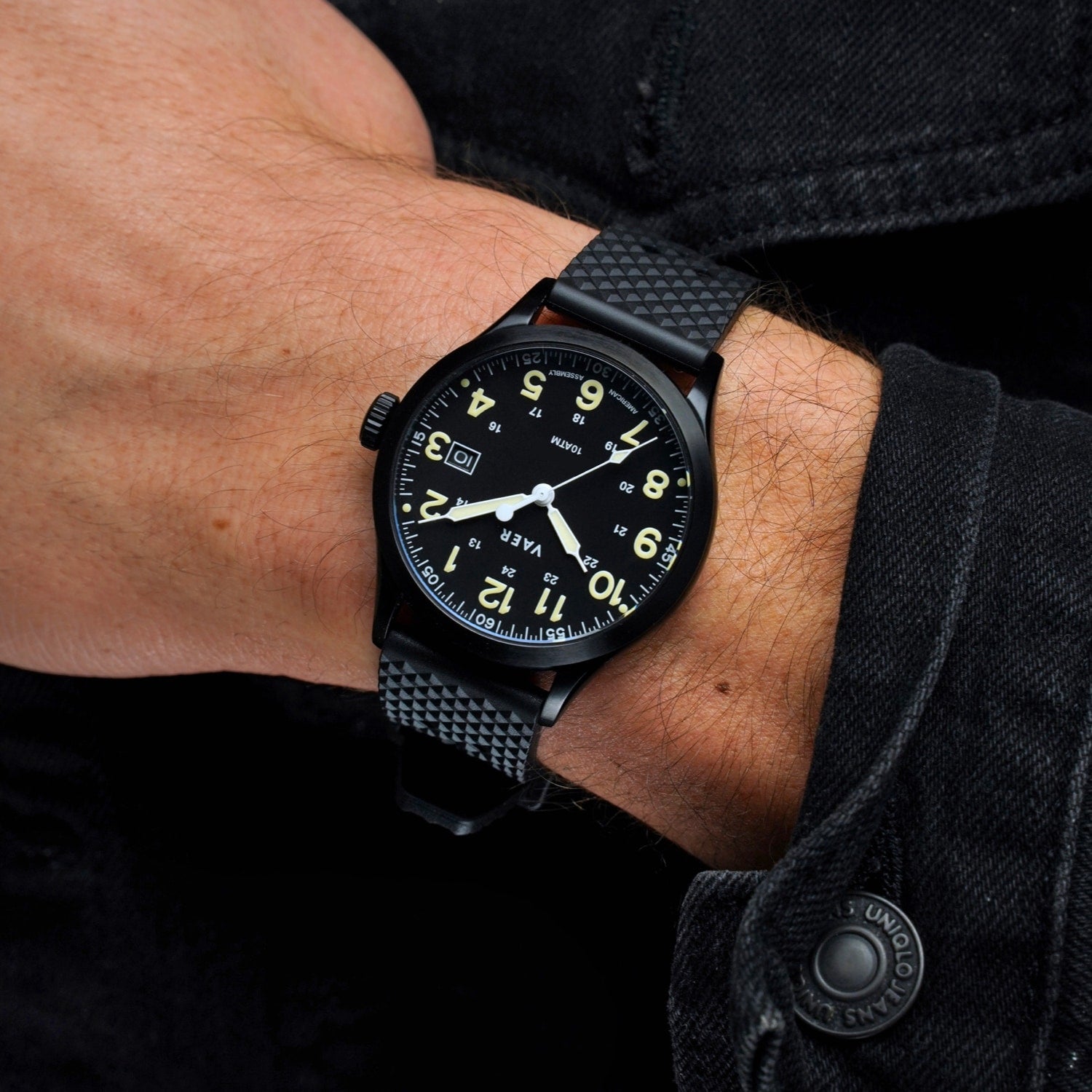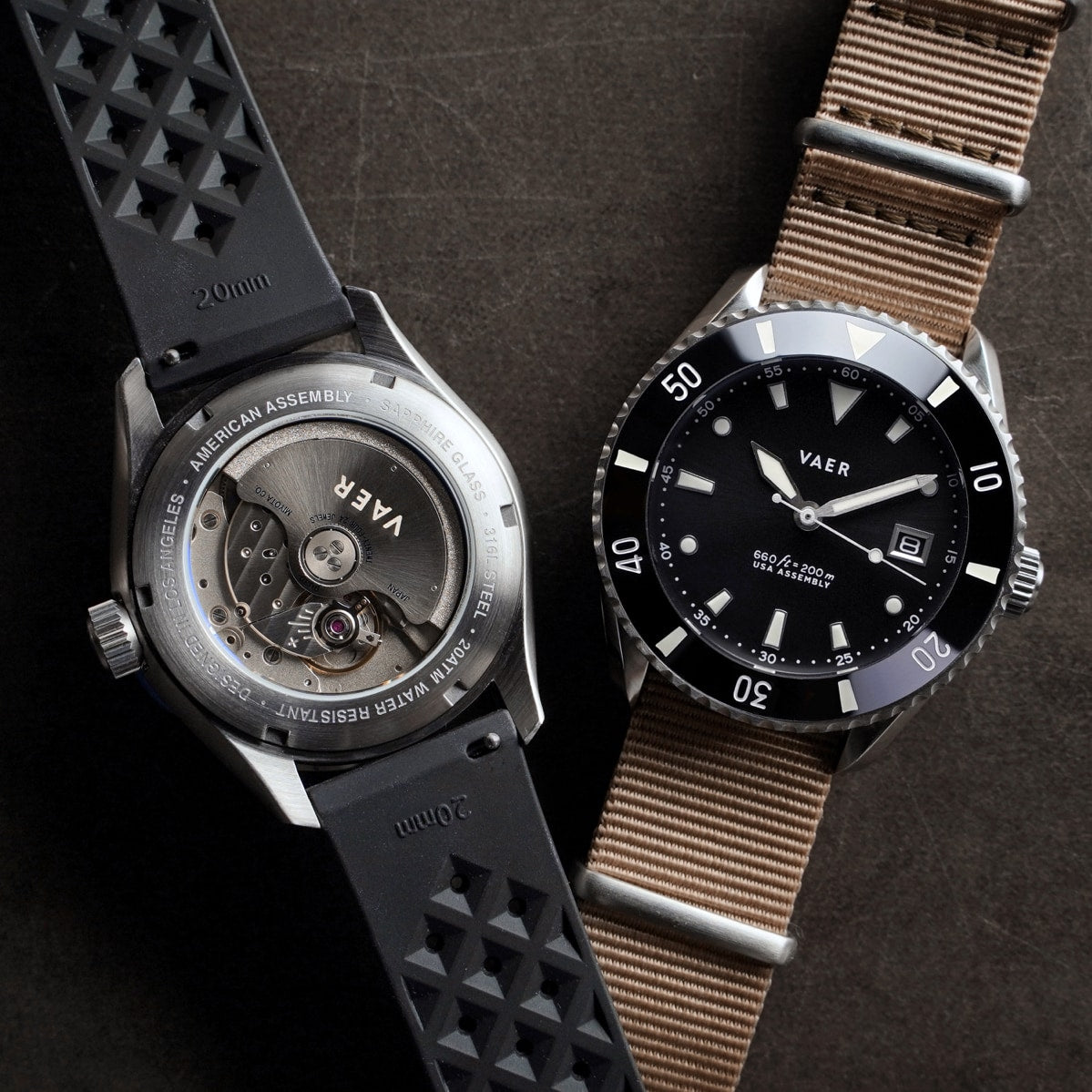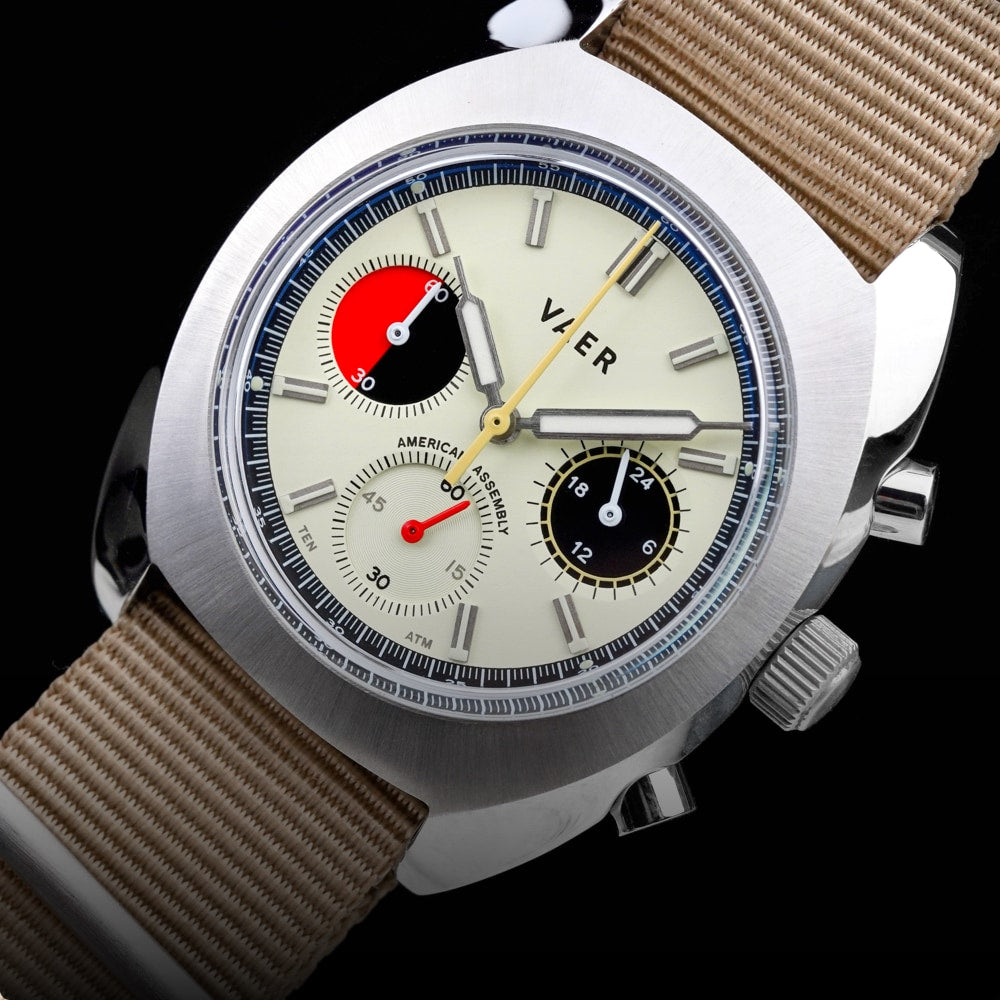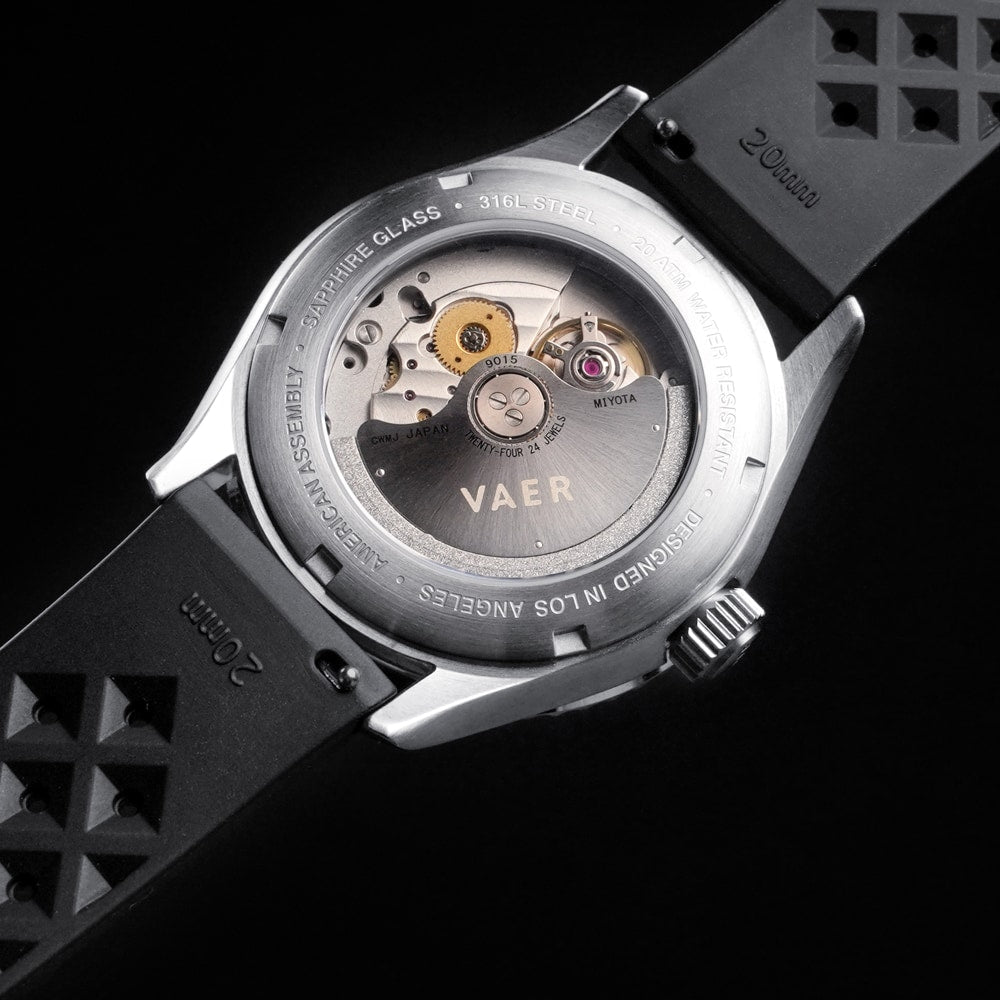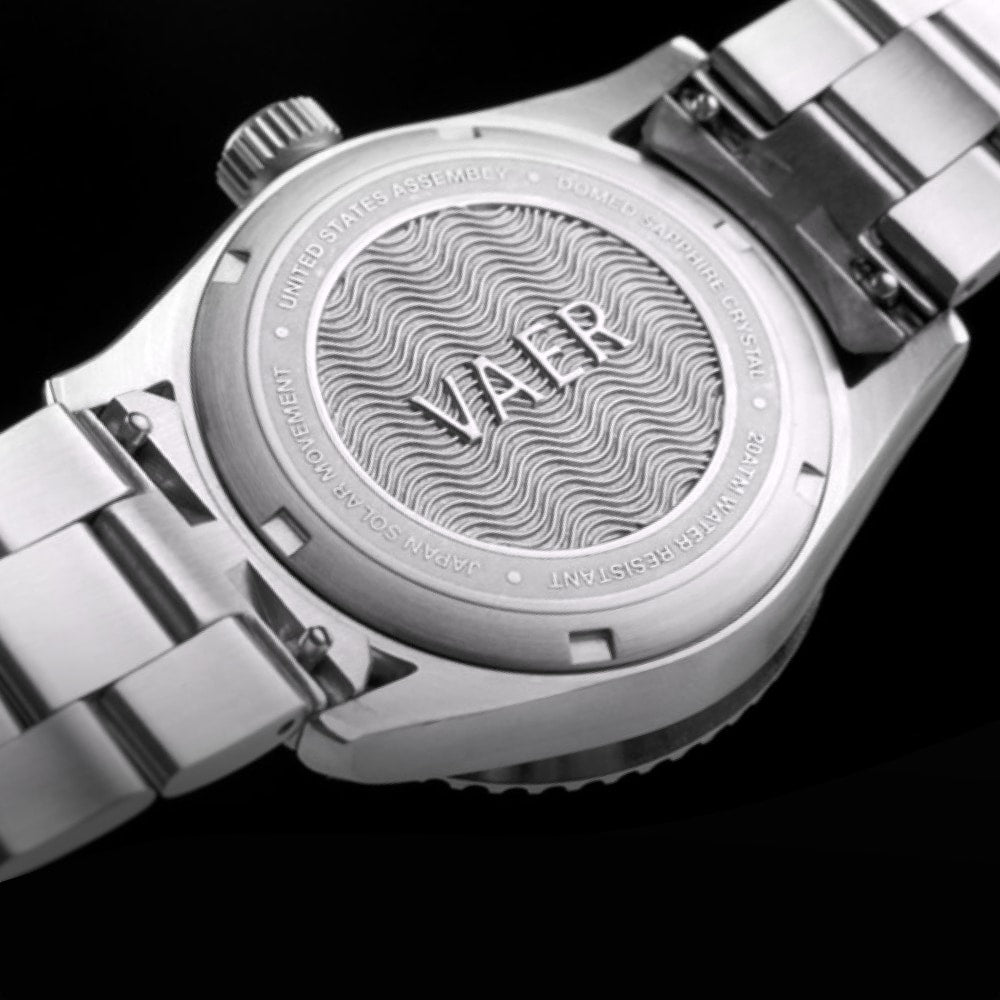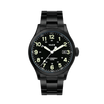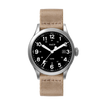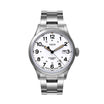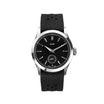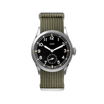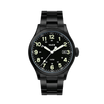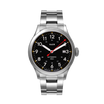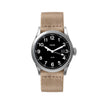Watch Care and Maintenance
Setting The Time
In order to set the time, unscrew the crown counterclockwise. Once the crown is disengaged from the threading, pull out until you feel a gentle click. If your watch has a date function, then the first click will be to change date and the second click will be for the time. Turn the crown and adjust the time/date as needed. When the time/date is set, click the crown back in, and rotate clockwise while applying pressure to seal the crown. It should be tight, but not difficult to unscrew. The gasket sealed crown ensures water resistance, and it must be screwed and sealed during water exposure to maintain warranty.
Bands
We offer a variety of bands, each listed below. Refer to the “Installation Guide” within this insert for next steps on setting up and changing straps.
Ocean Ready Straps - Straps Ready for Water and Ocean Use
- Nylon Single Pass
- Nylon Quick Release
- Silicone Quick Release
Horween Straps - Made in the USA from Top Quality Horween Hide
- Horween Single Pass
- Horween Quick Release
Band Installation
All of our watches are shipped with two interchangeable straps. Our standard nylon strap option utilizes a ‘pass-through’ design which is common on watches intended for ocean use. Unlike a traditional watch strap, which is made of two pieces and attached to the watch with removable springbars, our nylon pass-through straps are made of a single piece that can be removed or installed in seconds. To install the slide through strap, simply feed the tail end through each of the two springbars starting from the top of the watch.
Depending on the size of your wrist you may have extra length of nylon extending beyond the last keeper loop. Simply fold back the tag end of the strap through the keeper (see Figure A). To secure the extra length, feed the strap back toward the buckle until it is tightly secured (see Figure B).
If you’ve chosen to add a two-piece quick release strap to your order (or want to attach a third-party strap) you will need to remove pre-installed springbars on the watch. To remove the springbars, pinch the bar at the point where it comes in contact with the watch case. Maintain a firm grip on this section of the metal, and pull the spring downward. This will release the bar from the notch in the watch, and allow for easy removal. This can be done with a springbar tool, pliers, scissors, or even fingers. To re-install the bars, reverse this process by guiding the bar into the notch and allowing the spring to lock in place.
To attach the quick-release bands, position the end of the bar into the notch on the watch lugs and pull down the small metal knob on the other end to engage the spring (see Figure C). Align the loose end of the bar into the second notch, and release the tension of the spring to lock the band into place. Make sure the strap piece with the buckle is attached to the top of the watch case.
AUTOMATIC WINDING
Automatic movements are self winding and use a weighted rotor which turns as you move your arm. If you wear your watch while physically active, this winding will keep the watch close to full power. Unlike hand-wind-only movements, a clutch mechanism in the movement prevents automatic movements from being over-wound.
The Miyota 9015 is uni-directional winding, with the winding rotation being clockwise, looking at the watch from the back:
Most automatics will take many hundreds of rotations of the rotor to fully charge, so unless you are physically active while wearing it, it will be valuable to hand-wind your watch to enable it to keep best time.
CROWN USAGE AND HAND WINDING
Automatic movements used in Vaer watches can be hand wound, adding power to keep a watch running, and maintain accuracy, both of which decrease as the power winds down.
Hand-winding is more efficient than winding through wear - while the rotor needs to spin many hundreds of times in wear to fully charge, the Miyota 9015 in our A5 series only requires 40 clockwise turns of the crown for full power.
Our screw-down crowns are spring-loaded and will pop out when the crown is unscrewed and the threads disengage from the case tube.
Always be sure that your screw-down crown is fully secured when in wear and in water usage to ensure water resistance.
Crown positions for winding, date setting, and time setting:
Most modern automatic movements are "hacking", which means the seconds hand will stop when the crown is in time-setting position.
Crowns on some newer watches may require a bit of use or break-in for lubricants inside the movement to be evenly distributed. While changing positions, you may find the crown slipping into a neutral, "free-wheeling" position where it does nothing. This should self-correct in a short amount of time, through continued use.
DATE SETTING INFORMATION
If your watch displays the date, it should automatically change around midnight.
But if your watch has stopped, manually setting the date between 9pm and 4am can damage the date-change mechanism. If your watch has stopped, the time displayed could be am, or pm.
To avoid causing damage, first advance the hours until you see the date change near 12am, then set the watch to the correct time, then set the watch to the correct date, so long as the current time is not between 9pm and 4am.
MAINTENANCE
Swiss mechanical movements (our A7 and A12 lines) should receive routine servicing or replacement no less frequently than 7 years. Japanese mechanical movements (our A5 line) may need some lubrication to the rotor if it becomes loud, but should otherwise not need maintenance for at least a decade.
ACCURACY
Mechanical movements are less accurate than quartz movements, as there are many more "physical" technical components at play.
All of our watches are adjusted before shipment to ensure that they are operating within the movement manufacturer's accuracy specifications. These specifications are the average daily rates when the watch is operating at full power.
-
ETA 2824/ETA 2895 - Average daily rate of +/- 25 seconds/day
- Miyota 9015 - Average daily rate of -10 to +30 seconds/day
There are many factors (temperature, activity, power, etc.) that will vary performance over any day. As the watch's charge runs down (especially below 1/2 of its power reserve), the accuracy will change.
A watch may run fast or slow if the balance of a watch may be damaged from impact - this will require adjustment by a watch maker and is not covered by warranty.
If your watch begins to run very fast (minutes per day), then it has likely become magnetized. This is not uncommon, as magnetic fields are all around us - this could occur from exposure to speakers, cell phones, computers, or a variety of other conditions. The process of demagnetizing (removing magnetization) is a relatively simply process that can be done by watchmakers at an affordable cost. If you enjoy taking on projects yourself, you can purchase a "degausser" on Amazon to demagnetize yourself. Warranty does not cover demagnetization of your watch.


